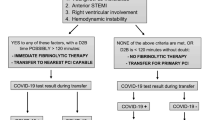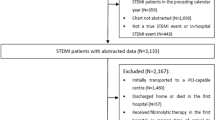Abstract
Background
Guidelines for the treatment of patients with ST-elevation myocardial infarction (STEMI) recommend primary PCI as first choice therapy. This recommendation has been linked to defined time limits achievable in a logistic network for the treatment of ACS. In the present study we analyzed the difference in 6 months outcome between STEMI patients who were admitted directly to a PCI center and those requiring transfer for primary PCI.
Results
2,034 consecutive patients were included in the Bad Nauheim ACS registry. Admission diagnosis was STEMI in 1,057 (52%) patients (71% male, aged 63 ± 13). 637 (60%) patients were directly admitted for primary PCI with a time delay from first medical contact until admission in the PCI center of 64 min (IQR 45–90) at median and door-to-balloon time (DTB) at median 29 min (IQR 20–41). 420 (40%) patients were transferred from peripheral hospitals. In this subgroup time delay was 135 min (IQR 69–285) and DTB at median 31 min (IQR 22–49). 178 (16.8%) patients were at high risk (CPR or cardiogenic shock). Patients, who were admitted directly had a better outcome as transferal patients (log rank 6.1; p = 0.013 for 6 months mortality). However, Kaplan–Meier survival analysis (log rank 4.25; p = 0.039) and Cox regression analysis (95% CI 1.08–3.17; p = 0.026) revealed that this difference in outcome was restricted to high-risk patients.
Conclusion
A network for the treatment of STEMI provides the logistic basis for the initiation of primary PCI according to current guidelines. However, transferal patients do not meet the defined time limits. Mortality rates for high-risk transferal patients appear to be higher as those of patients taken directly to the center by the EMS.



Similar content being viewed by others
References
Nallamothu BK, Bradley EH, Krumholz HM (2007) Time to treatment in primary percutaneous coronary intervention. N Engl J Med 357(16):1631–1638
Brodie BR, Hansen C, Stuckey TD et al (2006) Door-to-balloon time with primary percutaneous coronary intervention for acute myocardial infarction impacts late cardiac mortality in high-risk patients and patients presenting early after the onset of symptoms. J Am Coll Cardiol 47:289–295
Terkelsen CJ, Christiansen EH, Sørensen JT et al (2009) Primary PCI as the preferred reperfusion therapy in STEMI: it is a matter of time. Heart 95(5):362–369
De Luca G, Biondi-Zoccai G, Marino P (2008) Transferring patients with ST-segment elevation myocardial infarction for mechanical reperfusion: a meta-regression analysis of randomized trials. Ann Emerg Med 52:665–676
Cantor WJ, Fitchett D, Borgundvaag B, for the TRANSFER-AMI Trial Investigators et al (2009) Routine early angioplasty after fibrinolysis for acute myocardial infarction. N Eng J Med 360:2705–2718
Zahn R, Schiele R, Gitt AK, for the Maximal Individual Therapy in Acute Myocardial Infarction (MITRA) and the Myocardial Infarction Registry (MIR) Study Groups et al (2001) Impact of prehospital delay on mortality in patients with acute myocardial infarction treated with primary angioplasty and intravenous thrombolysis. Am Heart J 142:105–111
Zimmermann S, Ruthrof S, Nowak K, Alff A, Klinghammer L, Schneider R, Ludwig J, Pfahlberg AB, Daniel WG, Flachskampf FA (2009) Short-term prognosis of contemporary interventional therapy of ST-elevation myocardial infarction: does gender matter? Clin Res Cardiol 98:709–715
The Task Force on the management of ST-segment elevation acute myocardial infarction of the European Society of Cardiology, Van de Werf F, Bax J, Betriu A et al (2008) Management of acute myocardial infarction in patients presenting with persistent ST-segment elevation. Eur Heart J 29:2909–2945
Bonzel T, Erbel R, Hamm CW et al (2008) Leitlinie Perkutane Koronarintervention (PCI). Clin Res Cardiol 97:513–547
Nieminen MS, Böhm M, Cowie MR, ESC Committee for Practice Guideline (CPG) et al (2005) Executive summary of the guidelines on the diagnosis and treatment of acute heart failure: the Task Force on Acute Heart Failure of the European Society of Cardiology. Eur Heart J 26(4):384–416
Wienbergen H, Gitt AK, Senges J (2005) Aktuelle Umsetzung der leitlinienkonformen Therapie des akuten ST-Strecken-Hebungsinfarkts in Deutschland. Herz 30:700–703
Maier B, Behrens S, Grafe-Bothe C, Kuckuck H, Roehnisch JU, Schoeller RG, Schuelen H, Theres HP (2010) Time of admission, quality of PCI care, and outcome of patients with ST-elevation myocardial infarction. Clin Res Cardiol 99(9):565–572
Krüth P, Zeymer U, Gitt A, Jünger C, Wienbergen H, Niedermeier F, Glunz HG, Senges J, Zahn R (2008) Influence of presentation at the weekend on treatment and outcome in ST-elevation myocardial infarction in hospitals with catheterization laboratories. Clin Res Cardiol 97:742–747
Bradley EH, Herrin J, Wang Y et al (2006) Strategies for reducing the door-to-balloon time in acute myocardial infarction. N Engl J Med 355:2308–2320
Dudek D, Siudak Z, Dziewierz A et al (2008) Local hospital networks for STEMI treatment for a population of half a million inhabitants increase the use of invasive treatment of acute coronary syndromes to the European recommended level. The Małopolska Registry of Acute Coronary Syndromes 2005–2006. Kardiol Pol 66:489–497
Schneider H, Ince H, Rehders T, Drip&Ship-Netzwerk (District of Rostock Infarct Project & Shipping Patients) et al (2007) Treatment of acute ST elevation myocardial infarction in a regional network (“Drip & Ship Network Rostock”). Herz 32(8):635–640
Bauer T, Hoffmann R, Jünger C, Koeth O, Zahn R, Gitt A, Heer T, Bestehorn K, Senges J, Zeymer U (2009) Efficacy of a 24-h primary percutaneous coronary intervention service on outcome in patients with ST-elevation myocardial infarction in clinical practice. Clin Res Cardiol 98:171–178
Dhruva VN, Abdelhadi SI, Anis A et al (2007) ST-segment Analysis Using Wireless Technology in Acute Myocardial Infarction (STAT-MI) trial. J Am Coll Cardiol 50:509
Strauß M, Gitt AK, Becker T, Kleemann T, Schiele R, Darius H, Juenger C, Senges J, Seidl K for the MITRA PLUS study group (2008) Prehospital cardiac arrest: a marker for higher mortality in patients with acute myocardial infarction and moderately reduced left ventricular function: results from the MITRA plus registry. Clin Res Cardiol 97:748–752
Dong-bao L, Qi H, Zhi L, Shan W, Wei-ying J (2009) Predictors and short-term prognosis of angiographically detected distal embolization after emergency percutaneous coronary intervention for ST-elevation acute myocardial infarction. Clin Res Cardiol 98:773–779
Kammler J, Kypta A, Hofmann R, Kerschner K, Grund M, Sihorsch K, Steinwender C, Lambert T, Helml W, Leisch F (2009) TIMI 3 flow after primary angioplasty is an important predictor for outcome in patients with acute myocardial infarction. Clin Res Cardiol 98:165–170
De Luca G, Suryapranata H, Marino P (2008) Reperfusion strategies in acute ST-elevation myocardial infarction: an overview of current status. Prog Cardiovasc Dis 50(5):352–382
Koeth O, Zahn R, Heer T, Bauer T, Juenger C, Klein B, Gitt AK, Senges J, Zeymer U (2009) Gender differences in patients with acute ST-elevation myocardial infarction complicated by cardiogenic shock. Clin Res Cardiol 98:781–786
Assessment of the Safety and Efficacy of a New Treatment Strategy with Percutaneous Coronary Intervention (ASSENT-4 PCI) Investigators (2006) Primary versus tenecteplase-facilitated percutaneous coronary intervention in patients with ST-segment elevation acute myocardial infarction (ASSENT-4 PCI): randomized trial. Lancet 367:569–578
Di Mario C, Dudek D, Piscione F, CARESS-in-AMI (Combined Abciximab RE-teplase Stent Study in Acute Myocardial Infarction) Investigators et al (2008) Immediate angioplasty versus standard therapy with rescue angioplasty after thrombolysis in the Combined Abciximab REteplase Stent Study in Acute Myocardial Infarction (CARESS-in-AMI): an open, prospective, randomised, multicentre trial. Lancet 371(9612):559–568
Ellis SG, Tendera M, de Belder MA, van Boven AJ, Widimsky P, Janssens L, Andersen HR, Betriu A, Savonitto S, Damaus J, Peruga JZ, Kosmider M, Katz O, Neunteufl T, Jorgova J, Dorobantu M, Grinfeld L, Armstrong P, Brodie BR, Herrmann HC, Montalescot G, Neumann FJ, Effron MB, Barnathan ES, Topol EJ, FINESSE Investigators (2008) Facilitated PCI in patients with ST-elevation myocardial infarction. N Engl J Med 358(21):2205–2217
Mehta RH, Harjai KJ, Cox D, Primary Angioplasty in Myocardial Infarction (PAMI) Investigators et al (2003) Clinical and angiographic correlates and outcomes of suboptimal coronary flow in patients with acute myocardial infarction undergoing primary percutaneous coronary intervention. J Am Coll Cardiol 42:1739–1746
Keeley EC, Boura JA, Grines CL (2003) Primary angioplasty versus intravenous thrombolytic therapy for acute myocardial infarction: a quantitative review of 23 randomised trials. Lancet 361:13–20
Andersen HR, Nielsen TT, Rasmussen K, DANAMI-2 Investigators et al (2003) A comparison of coronary angioplasty with fibrinolytic therapy in acute myocardial infarction. N Eng J Med 349:733–742
Widimský P, Budesínský T, Vorác D, ‘PRAGUE’ Study Group Investigators et al (2003) Long distance transport for primary angioplasty vs. immediate thrombolysis in acute myocardial infarction. Final results of the randomized national multicentre trial–PRAGUE-2. Eur Heart J 24(1):94–104
BØhmer E, Hoffmann P, Abdelnoor M et al (2010) Efficacy and safety of immediate angioplasty versus ischemia-guided management after thrombolysis in acute myocardial infarction in areas with very long transfer distances results of the NORDISTEMI (NORwegian study on District treatment of ST-elevation myocardial infarction). J Am Coll Cardiol 55(2):102–110
Bauer T, Möllmann H, Weidinger F et al (2010) Use of platelet glycoprotein IIb/IIIa inhibitors in diabetics undergoing PCI for non-ST-segment elevation acute coronary syndromes: impact of clinical status and procedural characteristics. Clin Res Cardiol 99:275–383
Busk M, Maeng M, Rasmussen K, DANAMI-2 Investigators et al (2008) The Danish multicentre randomized study of fibrinolytic therapy vs. primary angioplasty in acute myocardial infarction (the DANAMI-2 trial): outcome after 3 years follow-up. Eur Heart J 29(10):1259–1266
Author information
Authors and Affiliations
Corresponding author
Rights and permissions
About this article
Cite this article
Liebetrau, C., Szardien, S., Rixe, J. et al. Direct admission versus transfer of AMI patients for primary PCI. Clin Res Cardiol 100, 217–225 (2011). https://doi.org/10.1007/s00392-010-0231-x
Received:
Accepted:
Published:
Issue Date:
DOI: https://doi.org/10.1007/s00392-010-0231-x




